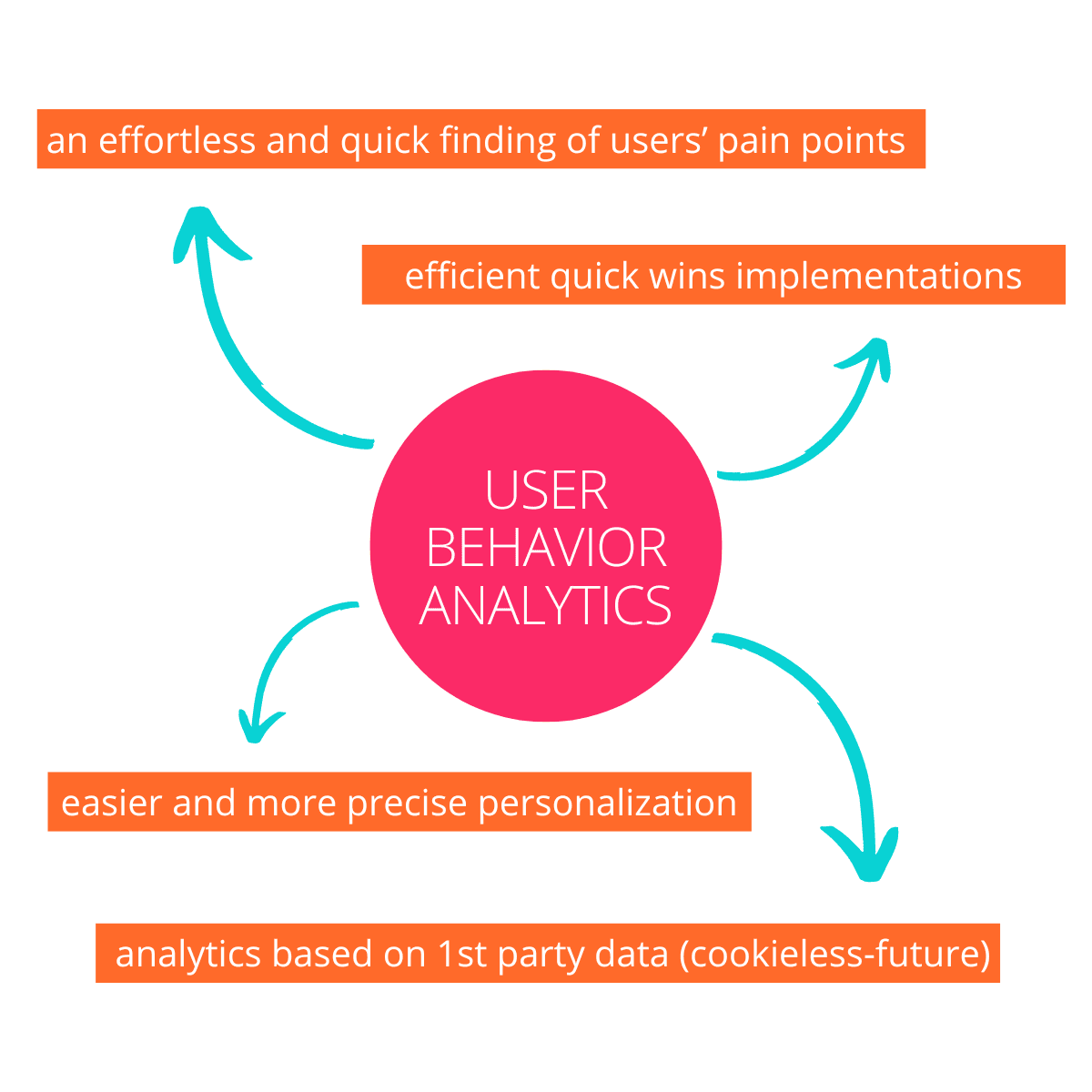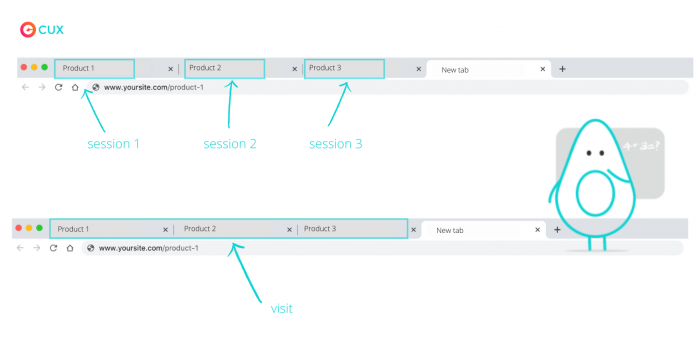December 8, 2022
7 min read
What is behavioral analytics in e-commerce and what do you need it for?
Predictions for 2023 clearly indicate that eCommerce is taking over the retail sales world. The expected sales for the upcoming year should be 20% of the total market, and by the end of 2026, it should cover 25%
No wonder you have taken this direction, regardless if you sell first needs products, luxury goods, services, or ideas. Currently, eCommerce is the right place to be.
What is user behavior analytics in eCommerce
Understanding different people is not an easy task. In the customer-centric era and data-driven marketing, you need to know the essentials of behavioral analytics in eCommerce. Otherwise, you won’t build any significant advantage, especially in the eCommerce segment. It’s no wonder that one of the driving forces of most eCommerce is behavioral analytics.
Behavior analytics in retail allows gathering, processing, and analyzing data to help eCommerce stores to understand their online customers: what they want, what they’re looking for, how long it takes for them to finalize the purchase, and what they think is missing in your eCommerce store.
Use behavioral analytics to:
- adjust your offer to customer segments,
- run effective paid campaigns tailored to customer expectations,
- personalize your digital products,
- empower your sales activities
- increase customer loyalty and retention,
- map real customer journey,
- find bottlenecks in your products that can hold your customers from converting.
Applying behavioral analytics in eCommerce
For some time, behavior analytics has been a standard fare for big players such as Amazon, Zalando, or T-Mobile.
Have you ever wondered how it is possible that the big brands can always send you a perfect list of items that you probably would like to buy, even though you have never seen them? It’s not magic, it’s a perfect example of the use of behavior analytics.
But right now, not only huge enterprises use behavioral analytics in their daily routine. Small and medium eCommerce stores also take advantage of using behavioral analytics.
Because at the end of the day it doesn’t matter how significant your company is. To achieve desirable turnover you need to understand your customer behavior – what they want, what are their needs, and when is the perfect moment for them to purchase.
From a marketer's point of view
Running effective paid campaigns, and optimizing your marketing activities can be quite a challenge. Every marketing specialist who deals with paid campaigns knows that.
Let’s discuss an example: you have high traffic on your campaign links, but only few customers purchase. In that case, you can take advantage of CUX’s grouped heatmaps.
It allows you to analyze the behavior of only those customers who came to your site from a specific source, in this case from paid campaigns.
By analyzing grouped heatmaps you will be able to find what interests the most customers or what’s not working.
From a sales point of view
Cooperation between the marketing and sales department has never been so tight. Times when the sales team contacts potential customers via phone are over. Especially in eCommerce.
Right now it is the marketing that is responsible for generating new leads, nurturing them with personalized content such as newsletter, special offers or paid campaigns and turning them into loyal customers.
By following users’ online habits and analyzing behaviors the sales team can find a perfect occasion for upselling or cross-selling tailored to customer needs.
From a customer service point of view
Behavioral analytics in eCommerce can be a true mine of knowledge to provide the best customer service.
Behavioral data can help you find frustration triggers which may cause drops in conversion and lead to customer churn.
Latest statistics proved that 32% of customers would abandon even their beloved brand after a single bad experience on the page.
There is no time to waste. Analyze what makes your customers angry, what frustrates them, what part of the customer journey is the most problematic one and implement improvements.
How do behavioral analytics tools work?
After all those pats on the back, you probably can’t wait to apply behavioral analytics to your eCommerce. But how to do that?
You can find on the market dedicated tools for behavioral analytics, they might also appear under the name of user behavioral analytics (UBA) tools. or dedicated customer service analytics software.

Their main task is to gather and analyze data from users' actions in the eCommerce store. With the help of AI, companies can find out what stands behind user behavior. Don’t be ashamed of yourself, there is nothing wrong with it. Most of those tools work according to GDPR and value customers’ privacy.
Key features of every behavioral analytics tool
Each tool offers slightly different features, subscription plans or amounts of data that can be collected. But there are a few features that remain an integral part of almost every behavioral analytics tool.
Heatmaps
Heatmaps are graphic visualizations of all users’ engagement, not necessarily only pleasant. They visualize the user’s activity through spots of different colors and sizes.
There 3 types of them:
- heatmaps – show what users clicked;
- linkmaps – present what links customers clicked but nothing more;
- scrollmaps – show how deep customers went in the page
It’s worth checking if analytics tools provide both – heatmaps and linkmaps. With linkmaps, which only refer to places that contain links, you won’t be able to find non-clickable elements that your customer may click.

Users’ session recordings
Almost every behavioral analytics tool allows you to see every customer interaction. Every click, scroll, mouse or chaotic movement.
It’s not like you were watching them from across the street or behind a curtain. With session recordings it is more like sitting behind them and looking over their shoulders to see exactly what is happening on their screen.
Unfortunately, session recordings will not give you a full picture of your customer behavior. To see that you need to analyze recordings of visits rather than sessions.

Web analytics
Through web analytics you can get a different sneak peek of your customers and their behavioral patterns – what kind of browsers they use, what kind of devices or operational system they are keen on.
Web analytics also indicates which platform, operating systems or browsers bring the most conversions.

Some behavioral analytics tools have an option of checking what kind of devices customers are using.
It’s really important because it has become customary that mobile users are not converting. But according to stats from Outerbox, 79% of smartphone users have made a purchase online using their mobile device in the last 6 months.
Behavioral analytics tool
Understanding customers' needs plays a pivotal role in successful eCommerce. To win customers’ hearts and increase customer lifetime value eCommerce need to conduct the best service, product, or offer that meets their customer's expectations.
It's the only way to do it and a behavioral analytics tool will help. No matter if you offer a product or service, have a website or app, or if you are eCommerce.
Behavioral analytics solution – cux.io
There are dozens of behavioral analytics tools on the market. But in this article we focus only on the one – CUX. We know that the competition doesn’t have to be worse and is just slightly different, but we don't want to bore you.
CUX is the very first UX & Automation tool that immediately finds users’ frustration and pain points that lead to conversion drops.
Let’s be honest, if your customers come across too many obstacles (and sometimes even one is too much), they will not bother moving forward in their customer journey. More likely they will abandon it. That’s why CUX is focusing on user journey analytics.
CUX's help, you can quickly spot the exact moments when your users become frustrated, and eliminate them.
Don’t believe me? Sign up for a free trial version where you can gather up to 1k Visits Recordings. There’s no use waiting.

